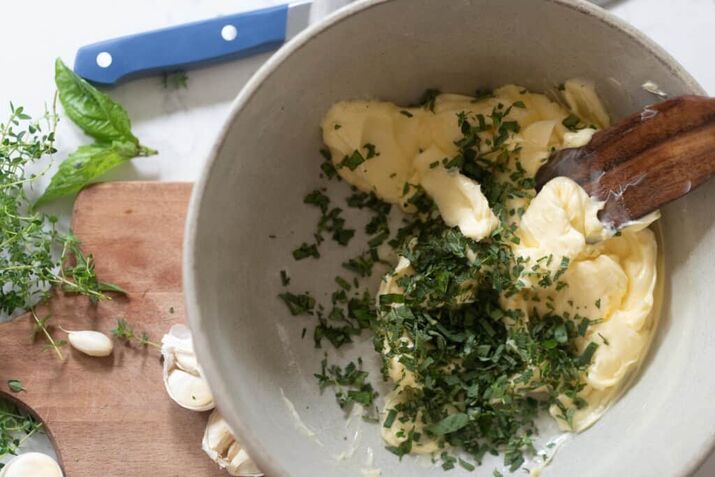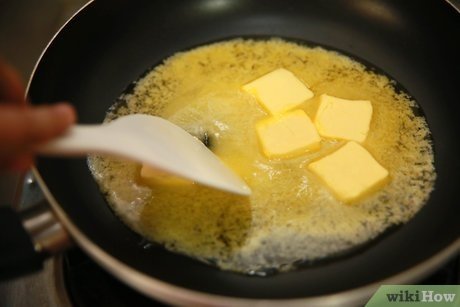If you’re looking for a way to elevate your pasta without spending hours in the kitchen, this herb butter sauce for pasta is your answer. With just a few simple ingredients, you can create a rich, aromatic sauce that clings to every strand of spaghetti or twirls around every forkful of fettuccine.
It’s the perfect blend of garlic, fresh herbs, and buttery goodness—ideal for a quick weeknight dinner or a cozy weekend meal. Whether you’re a pasta pro or just love a good, easy recipe, this herb butter sauce is sure to become a staple in your kitchen. Let’s dive into this savory sensation!

Ingredients
Butter
Butter forms the rich and creamy base of the herb butter sauce. Use high-quality unsalted butter for the best flavor. The butter should be fresh and free from any off odors or flavors, as it is the foundation of your sauce. Unsalted butter is preferred because it allows you to control the salt content in your dish.

Butter is not only the base of this sauce but also the key to its luxurious texture. When selecting butter, consider European-style butter, which has a higher fat content and richer flavor. The extra fat provides a creamier, more decadent mouthfeel, making the sauce even more indulgent. Make sure the butter is at room temperature before you begin, as this ensures it melts evenly without separating.
Fresh Herbs (e.g., basil, thyme, rosemary)
Fresh herbs are the star of this sauce, providing a burst of flavor and aroma. Popular choices include basil, thyme, and rosemary, but you can also experiment with parsley, oregano, or sage. Fresh herbs should be vibrant and fragrant, without any signs of wilting or yellowing. Finely chop the herbs to release their essential oils, which will infuse the butter with their flavors.
Each herb brings its unique profile to the sauce. Basil offers a sweet, peppery flavor with hints of anise, while thyme provides earthy, minty notes. Rosemary adds a pine-like aroma and slightly bitter taste that can cut through the richness of the butter. When combining herbs, balance their flavors to create a harmonious blend. For example, pair the delicate sweetness of basil with the robust earthiness of thyme for a well-rounded sauce.

Optional Additions (e.g., garlic, Parmesan cheese)
To enhance the flavor of your herb butter sauce, consider adding garlic or Parmesan cheese. Fresh garlic can be minced and sautéed in the butter for a subtle kick, while grated Parmesan adds a savory, umami depth. These additions are optional but can elevate your sauce to new heights. Other possible additions include a pinch of red pepper flakes for heat or a splash of white wine for acidity.
Garlic, when sautéed in butter, transforms into a sweet, mellow flavor that complements the fresh herbs beautifully. If you prefer a more pronounced garlic taste, you can use roasted garlic, which has a caramelized sweetness. Parmesan cheese, with its salty, nutty character, not only enhances the flavor but also adds a slightly grainy texture that enriches the sauce. For a touch of elegance, consider finishing the sauce with a splash of white wine or a squeeze of fresh lemon juice.
Step-by-Step Instructions in making Herb Butter Sauce for Pasta

Preparing the Ingredients
Before you start cooking, ensure all your ingredients are ready. Finely chop the fresh herbs and mince any garlic you plan to use. Grate the Parmesan cheese if you are using it. Having everything prepped and within reach will make the cooking process smooth and efficient.
Preparation is key to a seamless cooking experience. Organize your ingredients in small bowls or on a tray. This method, known as “mise en place,” ensures that you have everything you need at your fingertips, preventing any last-minute scrambles. Additionally, this preparation allows you to focus on cooking without interruptions, leading to a more enjoyable and successful cooking session.

Preparing the Ingredients
Before you start cooking, ensure all your ingredients are ready. Finely chop the fresh herbs and mince any garlic you plan to use. Grate the Parmesan cheese if you are using it. Having everything prepped and within reach will make the cooking process smooth and efficient.
Preparation is key to a seamless cooking experience. Organize your ingredients in small bowls or on a tray. This method, known as “mise en place,” ensures that you have everything you need at your fingertips, preventing any last-minute scrambles. Additionally, this preparation allows you to focus on cooking without interruptions, leading to a more enjoyable and successful cooking session.
Melting the Butter
In a medium-sized saucepan, melt the butter over low heat. It’s important to use low heat to prevent the butter from burning or browning too quickly. Stir the butter occasionally to ensure it melts evenly and doesn’t separate. Once the butter is fully melted and has a smooth, velvety texture, you can move on to the next step.
The key to melting butter is patience. Using low heat helps maintain the butter’s integrity, preserving its creamy consistency. As the butter melts, you can gently swirl the pan to encourage even melting. If you notice any foam or milk solids forming on the surface, skim them off with a spoon for a purer, clearer butter base. This step is especially crucial if you’re aiming for a smooth, silky sauce.

Adding Herbs
Once the butter is melted, add the finely chopped herbs to the saucepan. Stir gently to combine. If you’re using garlic, add it at this stage and cook for about 1-2 minutes until fragrant. Be careful not to burn the garlic, as it can turn bitter. Continue to stir the mixture over low heat, allowing the herbs to infuse their flavors into the butter. This should take about 3-5 minutes.
As you add the herbs to the melted butter, you’ll notice their vibrant colors and aromas intensify. The gentle heat helps release the essential oils from the herbs, creating a rich, aromatic base for your sauce. If you prefer a more intense herb flavor, you can let the mixture simmer for a few extra minutes. Just be sure to keep the heat low to prevent the herbs from losing their fresh, bright character.

Tips for Perfect Herb Butter Sauce
Choosing the Right Herbs
The choice of herbs can make or break your herb butter sauce. Fresh herbs are essential for the best flavor, as dried herbs won’t provide the same vibrant taste. Basil, thyme, and rosemary are classic options, but don’t be afraid to experiment with other herbs like tarragon or chives. The key is to use herbs that complement each other and your dish.
When selecting herbs, consider the overall flavor profile you want to achieve. For a Mediterranean twist, use a combination of basil, oregano, and rosemary. For a more delicate, French-inspired sauce, try tarragon, chervil, and parsley. Remember that some herbs, like rosemary and sage, have strong flavors and should be used sparingly. Balance is crucial to ensure that no single herb overpowers the sauce.

Adjusting the Consistency
The consistency of your herb butter sauce can be adjusted to suit your preference. If the sauce is too thick, you can thin it out with a little pasta cooking water or a splash of white wine. If it’s too thin, let it simmer for a few extra minutes to reduce and thicken. You can also add a bit of flour or cornstarch to help thicken the sauce if needed.
To achieve the perfect consistency, start with a small amount of liquid and gradually add more until you reach your desired thickness. Pasta cooking water is ideal because it contains starch that helps bind the sauce to the pasta. For a richer, more decadent sauce, use cream or half-and-half instead of water. If you choose to use flour or cornstarch, create a slurry by mixing it with a small amount of cold water before adding it to the sauce to avoid lumps.

Variations and Additions
Adding Lemon Zest
For a bright and zesty twist, add lemon zest to your herb butter sauce. The citrusy aroma of lemon zest pairs beautifully with fresh herbs and butter, adding a refreshing note to the sauce. Simply grate the zest of one lemon and stir it into the sauce just before serving.
Lemon zest not only adds a fresh, tangy flavor but also enhances the overall complexity of the sauce. The natural oils in the zest release a burst of citrus fragrance, making the sauce more aromatic. For an even more pronounced lemon flavor, you can add a small amount of freshly squeezed lemon juice. This addition works particularly well with herbs like basil and parsley, which have a natural affinity for citrus.

Including Nuts
To add texture and a nutty flavor, consider including nuts in your herb butter sauce. Toasted pine nuts, almonds, or walnuts can be a delightful addition. Chop the nuts finely and sprinkle them over the sauce just before serving. They add a lovely crunch and a depth of flavor that complements the creamy butter and fresh herbs.
Toasting the nuts enhances their flavor and adds a pleasant crunch to the sauce. Spread the nuts in a single layer on a baking sheet and toast them in a preheated oven at 350°F (175°C) for about 5-7 minutes, or until golden brown. Be sure to watch them closely, as nuts can burn quickly. Once toasted, allow them to cool slightly before chopping and adding them to your sauce. The combination of buttery sauce and crunchy nuts creates a delightful contrast in texture.

Serving Suggestions
Best Pasta Types
Herb butter sauce pairs well with a variety of pasta types. Long, thin pasta like spaghetti, linguine, or fettuccine is ideal because it allows the sauce to coat the strands evenly. Short pasta like penne, rigatoni, or farfalle also works well, as the sauce can cling to the crevices and surfaces.
When choosing pasta, consider the shape and texture. Thin, delicate pasta like angel hair or capellini works well with light, silky sauces, while thicker pasta like pappardelle or tagliatelle can handle more robust, creamy sauces. For a more adventurous option, try serving the herb butter sauce over filled pasta like ravioli or tortellini. The rich, creamy sauce complements the flavors of the filling, creating a harmonious and satisfying dish.

Side Dishes

To complete your meal, serve your herb butter pasta with complementary side dishes. A fresh green salad with a light vinaigrette provides a crisp contrast to the rich sauce.
Garlic bread or a simple bruschetta can also be a great addition, adding a bit of crunch and additional flavor. For a more substantial meal, consider serving the pasta with grilled chicken, shrimp, or a vegetable medley.
When planning your side dishes, aim for a balance of flavors and textures. A crisp, refreshing salad with mixed greens, cherry tomatoes, and a lemon vinaigrette cuts through the richness of the butter sauce. Garlic bread, with its crunchy exterior and soft, garlicky interior, provides a satisfying contrast.
For a protein boost, grilled chicken or shrimp adds a savory element that complements the herb butter sauce beautifully. Roasted vegetables, like asparagus, bell peppers, or zucchini, add color and variety to your plate.
FAQ
Conclusion
Herb butter sauce for pasta is a versatile and delicious option that can elevate any meal. By using high-quality butter and fresh herbs, you can create a sauce that is rich, aromatic, and full of flavor. Experiment with different herbs and optional additions to make the sauce your own. Whether you’re serving it over your favorite pasta or as a side dish, this herb butter sauce is sure to impress.
Disclosure: Our blog contains affiliate links to products. We may receive a commission for purchases made through these links. However, this does not impact our reviews and comparisons. We try our best to keep things fair and balanced, in order to help you make the best choice for you.







